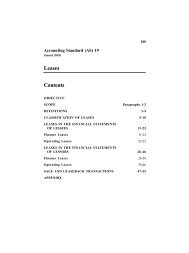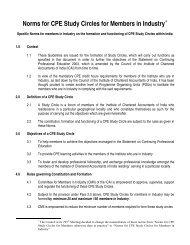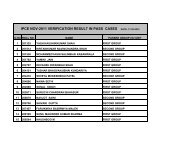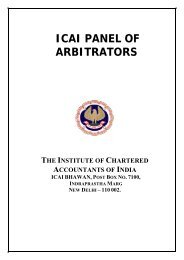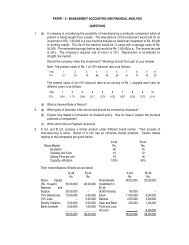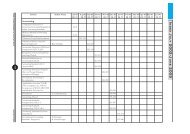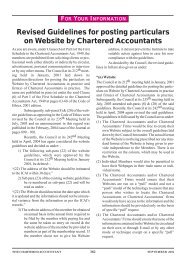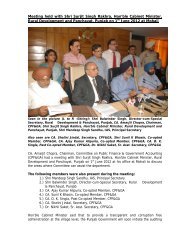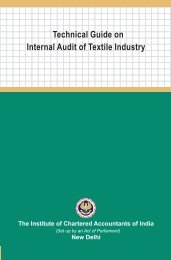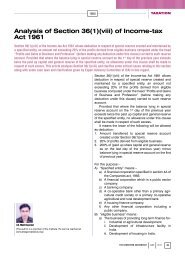The Chartered Accountant
The Chartered Accountant
The Chartered Accountant
Create successful ePaper yourself
Turn your PDF publications into a flip-book with our unique Google optimized e-Paper software.
in the preparation of financial statements<br />
as discussed in paragraph 2,<br />
management’s responsibility for the<br />
preparation and presentation of the<br />
financial statements includes a responsibility<br />
to assess the entity’s ability<br />
to continue as a going concern even<br />
if the financial reporting framework<br />
does not include an explicit requirement<br />
to do so.<br />
5. Management’s assessment of the<br />
entity’s ability to continue as a going<br />
concern involves making a judgment,<br />
at a particular point in time, about inherently<br />
uncertain future outcomes of<br />
events or conditions. <strong>The</strong> following<br />
factors are relevant to that judgment:<br />
l <strong>The</strong> degree of uncertainty associated<br />
with the outcome of an<br />
event or condition increases significantly<br />
the further into the future<br />
an event or condition or the<br />
outcome occurs. For that reason,<br />
financial reporting frameworks<br />
normally require an explicit<br />
management assessment specify<br />
the period for which management<br />
is required to take into account<br />
all available information.<br />
l <strong>The</strong> size and complexity of the<br />
entity, the nature and condition<br />
of its business and the degree to<br />
which it is affected by external<br />
factors affect the judgment regarding<br />
the outcome of events<br />
or conditions.<br />
l Any judgment about the future<br />
is based on information available<br />
at the time at which the<br />
judgment is made. Subsequent<br />
events may result in outcomes<br />
that are inconsistent with judgments<br />
that were reasonable at<br />
the time they were made.<br />
Responsibilities of the Auditor<br />
6. <strong>The</strong> auditor’s responsibility is to<br />
obtain sufficient appropriate audit<br />
evidence about the appropriateness of<br />
management’s use of the going concern<br />
assumption in the preparation<br />
and presentation of the financial statements<br />
and to conclude whether there is<br />
a material uncertainty about the entity’s<br />
DECEMBER 2008 1102 THE CHARTERED ACCOUNTANT<br />
STANDARDS<br />
ability to continue as a going concern.<br />
This responsibility exists even if the<br />
financial reporting framework used in<br />
the preparation of the financial statements<br />
does not include an explicit requirement<br />
for management to make a<br />
specific assessment of the entity’s ability<br />
to continue as a going concern.<br />
7. However, as described in SA 200, 6<br />
the potential effects of inherent limitations<br />
on the auditor’s ability to detect<br />
material misstatements are greater for<br />
future events or conditions that may<br />
cause an entity to cease to continue as<br />
a going concern. <strong>The</strong> auditor cannot<br />
predict such future events or conditions.<br />
Accordingly, the absence of any<br />
reference to going concern uncertainty<br />
in an auditor’s report cannot be viewed<br />
as a guarantee as to the entity’s ability<br />
to continue as a going concern.<br />
Effective Date<br />
8. This SA is effective for audits of<br />
financial statements for periods beginning<br />
on or after April 1, 2009.<br />
Objectives<br />
9. <strong>The</strong> objectives of the auditor are:<br />
(a) To obtain sufficient appropriate<br />
audit evidence about the appropriateness<br />
of management’s use<br />
of the going concern assumption<br />
in the preparation and presentation<br />
of the financial statements;<br />
(b) To conclude, based on the audit<br />
evidence obtained, whether a<br />
material uncertainty exists related<br />
to events or conditions that<br />
may cast significant doubt on<br />
the entity’s ability to continue as<br />
a going concern; and<br />
(c) To determine the implications<br />
for the auditor’s report.<br />
Requirements<br />
Risk Assessment Procedures and<br />
Related Activities<br />
10. When performing risk assessment<br />
procedures as required by SA 315, 7 the<br />
auditor shall consider whether there<br />
are events or conditions that may cast<br />
significant doubt on the entity’s abil-<br />
ity to continue as a going concern. In<br />
so doing, the auditor shall determine<br />
whether management has already performed<br />
a preliminary assessment of<br />
the entity’s ability to continue as a going<br />
concern, and: (Ref: Para. A2-A5)<br />
(a) If such an assessment has been<br />
performed, the auditor shall<br />
discuss the assessment with<br />
management and determine<br />
whether management has identified<br />
events or conditions that,<br />
individually or collectively, may<br />
cast significant doubt on the entity’s<br />
ability to continue as a going<br />
concern and, if so, management’s<br />
plans to address them;<br />
or<br />
(b) If such an assessment has not<br />
yet been performed, the auditor<br />
shall discuss with management<br />
the basis for the intended use<br />
of the going concern assumption,<br />
and inquire of management<br />
whether events or conditions<br />
exist that, individually or<br />
collectively, may cast significant<br />
doubt on the entity’s ability to<br />
continue as a going concern.<br />
11. <strong>The</strong> auditor shall remain alert<br />
throughout the audit for audit evidence<br />
of events or conditions that<br />
may cast significant doubt on the<br />
entity’s ability to continue as a going<br />
concern. (Ref: Para. A6)<br />
Evaluating Management’s Assessment<br />
12. <strong>The</strong> auditor shall evaluate management’s<br />
assessment of the entity’s<br />
ability to continue as a going concern.<br />
(Ref: Para. A7-A9; A11-A12)<br />
13. In evaluating management’s assessment<br />
of the entity’s ability to<br />
continue as a going concern, the auditor<br />
shall cover the same period as<br />
that used by management to make its<br />
assessment as required by the applicable<br />
financial reporting framework,<br />
or by law or regulation if it specifies<br />
a longer period. If management’s assessment<br />
of the entity’s ability to continue<br />
as a going concern covers less<br />
than twelve months from the date of<br />
6 SA 200 (AAS 1), “Basic Principles Governing an Audit” and SA 200A (AAS 2), “Objective and Scope of the Audit of Financial Statements” correspond to International<br />
Standard on Auditing (ISA) 200 (Revised and Redrafted). Both the SAs are currently being revised in the light of the ISA 200 (Revised and Redrafted). Post this revision, the<br />
principles covered by SA 200 (AAS 1) and SA 200A (AAS 2) will be merged into one standard, i.e., SA 200.<br />
7 SA 315 , “Identifying and Assessing the Risks of Material Misstatement Through Understanding the Entity and Its Environment”, paragraph 5.



